
Explanation and overview of the argumentative or persuasive essay. 9-minute video.
- Subject:
- Composition and Rhetoric
- English Language Arts
- Material Type:
- Diagram/Illustration
- Date Added:
- 06/25/2019

Explanation and overview of the argumentative or persuasive essay. 9-minute video.
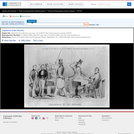
A dramatic portrayal, clearly biased toward the northern point of view, of an incident in Congress which inflamed sectional passions in 1856. The artist recreates the May 22 attack and severe beating of Massachusetts senator Charles Sumner by Representative Preston S. Brooks of South Carolina. Brooks's actions were provoked by Sumner's insulting public remarks against his cousin, Senator Andrew Pickens Butler, and against Illinois senator Stephen A. Douglas, delivered in the Senate two days earlier. The print shows an enraged Brooks (right) standing over the seated Sumner in the Senate chamber, about to land on him a heavy blow of his cane. The unsuspecting Sumner sits writing at his desk. At left is another group. Brooks's fellow South Carolinian Representative Lawrence M. Keitt stands in the center, raising his own cane menacingly to stay possible intervention by the other legislators present. Clearly no help for Sumner is forthcoming. Behind Keitt's back, concealed in his left hand, Keitt holds a pistol. In the foreground are Georgia senator Robert Toombs (far left) and Illinois senator Stephen A. Douglas (hands in pockets) looking vindicated by the event. Behind them elderly Kentucky senator John J. Crittenden is restrained by a fifth, unidentified man. Above the scene is a quote from Henry Ward Beecher's May 31 speech at a Sumner rally in New York, where he proclaimed, "The symbol of the North is the pen; the symbol of the South is the bludgeon." David Tatham attributes the print to the Bufford shop, and suggests that the Library's copy of the print, the only known example, may have been a trial impression, and that the print may not actually have been released. The attribution to Homer was first made by Milton Kaplan.|Probably printed by John H. Bufford, Boston.|Signed with monogram: WH (Winslow Homer).|Title appears as it is written on the item.|Tatham, "Pictorial Responses to the Caning of Senator Sumner," p. 15-16.|Forms part of: American cartoon print filing series (Library of Congress)|Published in: American political prints, 1766-1876 / Bernard F. Reilly. Boston : G.K. Hall, 1991, entry 1856-1.|Exhibited: American Treasures of the Library of Congress.
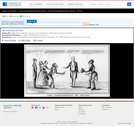
Signed in stone: J. Cn.|Title appears as it is written on the item.|Forms part of: American cartoon print filing series (Library of Congress)

Highlights from the past and present of Alaska, from the rich online collections of the Library of Congress.
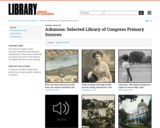
Highlights from the past and present of Arkansas, from the rich online collections of the Library of Congress.
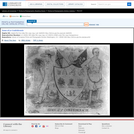
A small card bearing a vitriolic indictment of the Confederacy. The artist particularly attacks the the institution of slavery, the foundation of Southern economy. A large shield is flanked by two figures: a planter (left) and a slave. The planter wears spurs and a broad-brimmed hat and smokes a cigar. The slave is clad only in breeches, and his hands are manacled. Above the shield are two crossed flags, the Confederate flag and one bearing a skull and crossbones and the number 290. Between the flags are a rooster and a streamer with the motto "servitudo esto perpetua." On the shield are images associated with the South: a mint julep, a bottle of "Old Rye," a pistol and dagger, a whip and manacles, cotton, tobacco, and sugar plants, and slaves hoeing. In the background left, dominated by the palmetto tree of South Carolina, three planters, one holding a whip, play cards at a table. Beyond, two men duel with pistols. On the right, a female slave is auctioned as two slave children stand by and a black woman watches from a cabin doorway.|G.H. Heap Inv. [i.e., published].|H.H. Tilley Del. et Sc.|Title appears as it is written on the item.|Forms part of: American cartoon print filing series (Library of Congress)|Published in: American political prints, 1766-1876 / Bernard F. Reilly. Boston : G.K. Hall, 1991, entry 1862-13.

This resource is a video abstract of a research paper created by Research Square on behalf of its authors. It provides a synopsis that's easy to understand, and can be used to introduce the topics it covers to students, researchers, and the general public. The video's transcript is also provided in full, with a portion provided below for preview:
"Deep-sea hydrothermal vent ecosystems host an array of macrofauna, including many invertebrates. These animals adapt to the extreme conditions by forging endosymbiotic relationships with chemoautotrophic bacteria. Phages, viruses that infect prokaryotes, can fundamentally affect endosymbiotic bacteria, but their specific roles in deep-sea vent endosymbionts are not yet known. A recent study utilized metagenomics, transcriptomics, and proteomics to examine the endosymbiotic phages associated with the deep-sea vent snail Gigantopelta aegis. These phages infected methane- and sulfur-oxidizing bacteria, and there was evidence of both lysogenic and lytic lifecycles. The genomes also showed evidence of an arms race between bacteria and phages, with the bacteria encoding defense systems like CRISPR–Cas to break down phage DNA and the phages encoding their own anti-defense mechanisms. The phages also had horizontally acquired auxiliary metabolic genes, which could benefit replication..."
The rest of the transcript, along with a link to the research itself, is available on the resource itself.

Ernst Haeckel is a medical doctor, artist, philosopher, and naturalist of the late 1800s/early 1900s who beautifully and accurately depicted sea animal and plant life using color illustrations; you can find many examples of his sketches online through websites such as this one (Kuriositas, January 2012)and in his published works like Art Forms of Nature (1899). He promoted Darwin's theory of natural selection and created many words in the study of biology such as phylogeny and protist. I can see his work being used to inspire student observations, which are the basis of scientific discovery and study and as a supplement within specific units of biology including classification and evolution studies. I can also envision them being used during curriculum development within a professional development setting for teachers or a collaborative project integrating art and science instruction.

Art Interaction Mapping (AIM) is a creative brainstorming tool for advanced visual art projects. This framework was designed to help artists creatively integrate digital technologies with traditional mediums. These visualization models can be used to organize and structure ideas, refine concepts, or assess project outcomes.
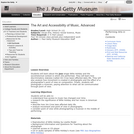
Students will learn about the jazz singer Billie Holiday and the sociohistorical context in which she performed. They will learn how discriminatory statutes (called Jim Crow laws) affected daily life. They will also analyze how movement is created in photographs and the effect of a photographer's point of view on composition. Finally, students will photograph a musician, paying attention to what can be communicated through point of view.
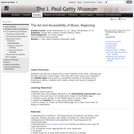
Students will discuss a page from a late-medieval choir book, including its function and how it was made. They will learn how music was notated in the Middle Ages and practice a simplified method of notating music. Working in teams, students will create a class choir book of songs of celebration.
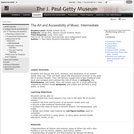
Students will discuss the form, function, and decoration of an ancient Greek wine cup. They will learn about the importance of music in the daily life of ancient Greeks. They will discuss a page from a late-medieval choir book and compare and contrast the role of music in antiquity, the Renaissance, and today. They will create cups for a social gathering inspired by ancient Greek symposia, and create and perform a song, poem, or story.
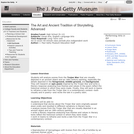
Students will analyze scenes from the Trojan War that are visually depicted in an ancient object and an 18th-century painting. They will research an epic poem inspired by the Trojan War and write a literary response analyzing how themes and values in the poem reflect the historical context in which they were made. Finally, they will work in teams to reframe a tale from the Trojan War in a contemporary context -- visually and in poetry -- and recite the tale in a poetry slam.
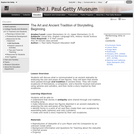
Students will discuss what is communicated in an ancient statuette by analyzing the size and poses of two figures. They will learn that stories were passed through oral tradition in ancient times. They will create sculptures of themselves, a companion, and a favorite musical instrument using spheres and cylinders, and then recite a story inspired by their sculptures.
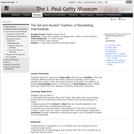
Students will learn about the Trojan War and the hero Achilles. They will compare different stories that were inspired by Achilles, which were passed down orally. They will analyze stories of Achilles in a relief on an ancient sarcophagus and in a drawing by a Renaissance artist. Finally, they will create their own drawing of Achilles inspired by literature.
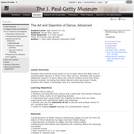
Students will examine three works of art to learn about the daily lives of working ballet dancers in Paris in the 19th century. Students will conduct additional research to learn about the cultural context at the time these dancers worked, including how ballet dancers were perceived. Finally, students will create a backstage view of a contemporary dancer.
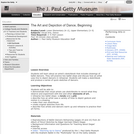
Students will learn about an artist's sketchbook that includes drawings of ballet dancers. They will practice two ballet steps and discuss how an artist uses line to depict dancers in rehearsal. Students will make a sketchbook and produce a series of quick sketches of dancers.
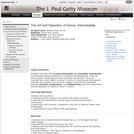
Students will learn about axial movements and locomotor movements by discussing dancers depicted in a drawing and photograph. They will then practice combining axial and locomotor movements. They will describe how artists depict a dancer's motion in drawing and photography. They will also analyze how an artist creates movement and emphasis through contrast, composition, and leading lines, and then experiment with photography to capture motion in dance.
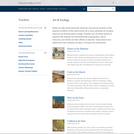
Artists are often particularly keen observers and precise recorders of the physical conditions of the natural world. As a result, paintings can be good resources for learning about ecology. Teachers can use this lesson to examine with students the interrelationship of geography, natural resources, and climate and their effects on daily life. It also addresses the roles students can take in caring for the environment. Students will look at paintings that represent cool temperate, warm temperate, and tropical climates.
In this lesson students will: Identify natural resources found in particular geographic areas; Discuss ways in which climate, natural resources, and geography affect daily life; Apply critical-thinking skills to consider the various choices artists have made in their representations of the natural world; Make personal connections to the theme by discussing ways they can be environmental stewards; Identify natural resources found in particular geographic areas; Discuss ways in which climate, natural resources, and geography affect daily life; Apply critical-thinking skills to consider the various choices artists have made in their representations of the natural world; Make personal connections to the theme by discussing ways they can be environmental stewards.
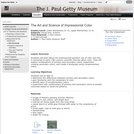
Students will learn about the Impressionist painters' use of color and how it connected to early-19th-century scientific theories about color. They will explore combinations of primary and secondary colors, experiment creating secondary colors, and create a landscape using complementary colors.